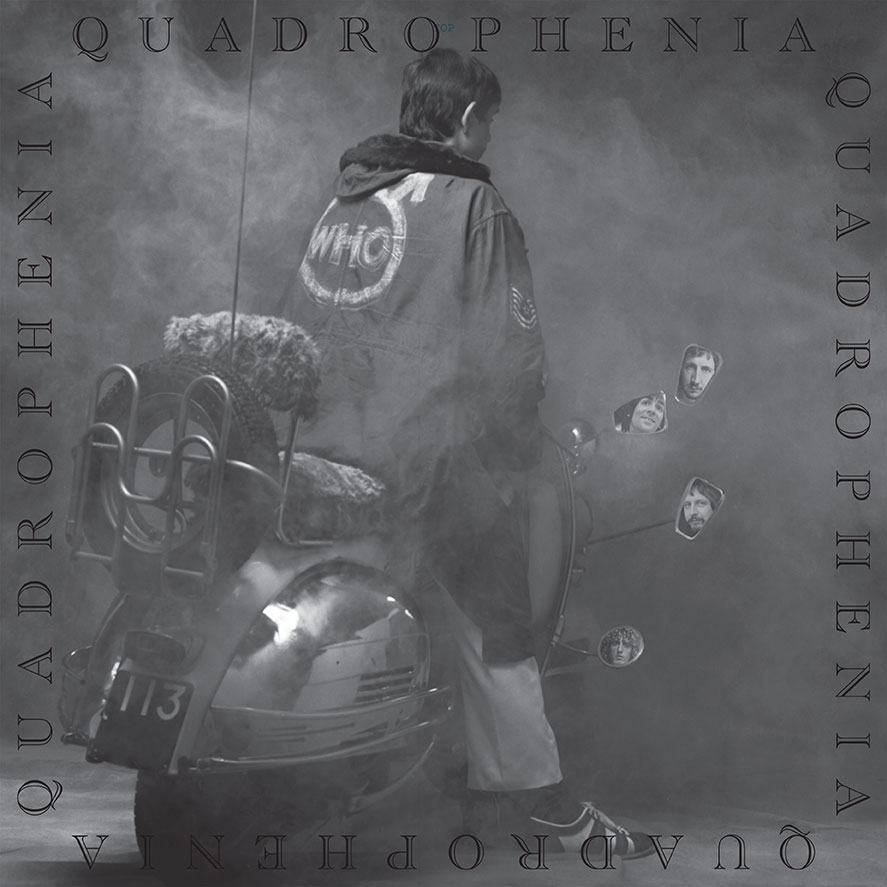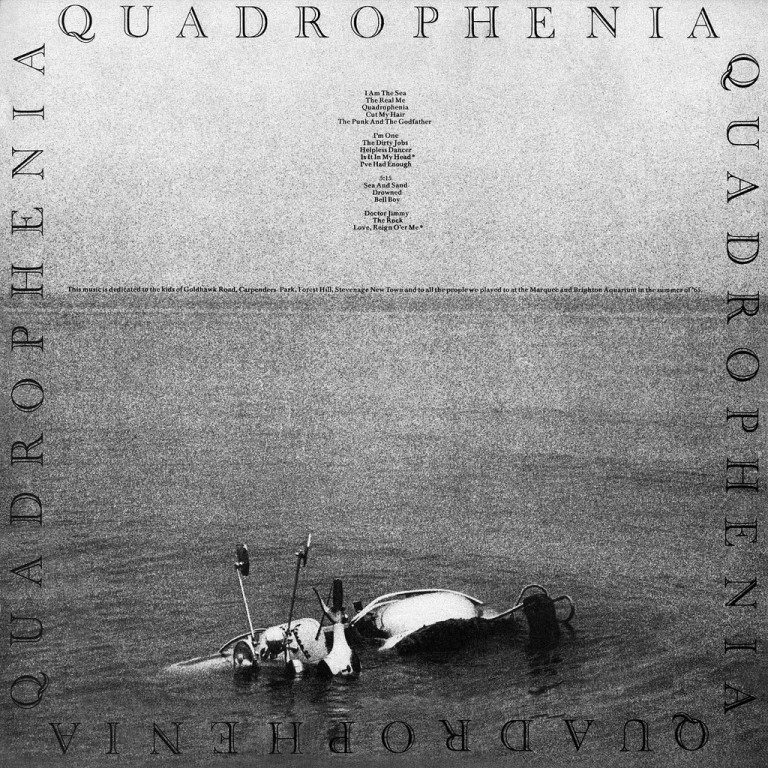Most popular Who album? No.
Most important Who album? No.
Most influential Who album? No.
Best Who album? Definitely.
More: Best album of the ‘70s? Probably.
More? Best rock album, ever? Possibly.
Quick question: have you ever heard this? (This song; this album.) Do yourself a favor: drop everything and give this a listen. It will change your perception of The Who. It might change your life.
Let’s break it down.
Quadrophenia is an album that has something for everyone and everything for some people. It concerns itself with virtually all the themes that have defined rock music through successive generations: alienation, rebellion, redemption. Sex. Drugs. And rock ‘n’ roll, as well as Mods, Rockers, punks, godfathers, bell boys, drunk mothers, distant fathers and fallen heroes. The sea, sand, surf and suicide. Rain, uppers, downers and drowning. Zoot suits, scooters, school and schizophrenia. Dirty jobs, helpless dancers, pills and gin. Stars falling, heat rising and, above all, love. Love of music, love of life and the love of possibility. Faith and the attempt to make a cohesive—not to mention coherent—statement on the meaning of all these things. And more.
Is that too much? More like it’s not enough.
Quadrophenia is, in no particular order, The Who album that has best defied time and fashion (one crucial criterion for measuring the ultimate impact of a successful work of art is how it fares over time), a guitar-playing tour de force, and Pete Townshend’s most realized conceptual effort. This is it: he was never this energized or inspired again; this is career-defining music. A double LP that is not as immediately approachable as Tommy, it takes a while but once you get it, it gets inside you—and never leaves.
The Who’s masterwork could almost be described as accidental beach music. Most of the narrative details the mercurial urgencies of young Jimmy, the disenchanted Mod who also could represent just about any teenager who has ever lived. As such, the words and sounds and feelings are alternately frantic (“Can You See The Real Me?”) and claustrophobic (“Cut My Hair”): the story of a sensitive, chemically altered kid uncomfortable inside his skin. There are few releases, and even the sex, drugs and rock ‘n’ roll can’t always be counted on.
The one place where he feels safe and free is at the beach. The album opens with crashing waves and ends with the electrified air of a summer storm. In between there are seagull chirps, scooters careening out of the city into open spaces, bass drum thunder and cymbal-splash raindrops. The album, like the protagonist’s mind, wrestles with itself, rising and falling like the moods of adolescence. Eventually, inevitably, the fever breaks, the skies open and the air is dark, cool and clear.
The genius of Quadrophenia (an album that manages to get name-checked by all the big names and seems universally admired but still not quite revered as much as it richly deserves to be) is certainly the sum of its parts, but also warrants, and welcomes, song-by-song scrutiny. Less flashy than the “rock opera” Tommy and less accessible than the FM-friendly Who’s Next (both masterpieces in their own right), Quadrophenia is, nonetheless, significantly more impressive (and indispensable) than both of those excellent albums.
Everything The Who did, in the studio and onstage, up until 1969 set the stage for Tommy: it was the consummation of Townshend’s obsessions and experimentations; a decade-closing magnum opus that managed to simultaneously celebrate the death and rebirth of the Hippie Dream. Everything Townshend did, in his entire life up until 1973 set the stage for Quadrophenia.
It’s all in there: the pre-teen angst, the teenage agonies and the post-teen despondency. Politicians and parents are gleefully skewered, prigs and clock punchers are mercilessly unmasked, and those who consider themselves less fortunate than everyone else (this, at times, is all of us) are serenaded with equal measures of empathy and exasperation.
And the songs? It’s like being in a shooting gallery, where Townshend picks off hypocrisy after misdeed after miniature tragedy all with a twinkling self-deprecation; this, after all, is a young misfit’s story, so the bathos and pathos is milked and articulated in ways that convey the earth-shattering urgency and comical banality that are part and parcel to the typical coming of age Cri de Coeur. And the band, certainly no slouch on its previous few efforts, is in top form throughout (isolating Moon and Entwistle on any track is a process that can yield ceaseless wonder and bewilderment, and provides a clinic for how multi-dimensional each player consistently managed to be).
From the extended workouts like the title track and “The Rock” (which sounds a bit like an updated and plugged-in version of Tommy’s “Underture”, to slash and burn mini epics like “Dr. Jimmy” to pre-punk (and post-Mod) anthems like “5:15”, the band is flexing rhythmic and textural muscles that are as big as any band’s ever got.
The attention to detail is striking and, for the time, remarkably innovative: consider the “found” sounds of the screeching scooters, the rain, the surf, the bus doors clanging open and, on “Bell Boy”, the sound of Keith Moon’s howl merging into the synthesizer (a technique later used to excellent effect on “Sheep” from Pink Floyd’s Animals).
There are the subtle yet masterful touches that are still capable of providing added pleasure after all these listens: the winking but ingenious meta of “My Generation” (in “The Punk and The Godfather”) and “The Kids are Alright” (in “Helpless Dancer”) as well as “I’m The Face” (in “Sea and Sand”). These are not just clever self-references, they are historical notes—from the history of The Who and, by extension and association, rock ‘n’ roll.
Being a double album (quite possibly the best one, and that is opined knowing that Electric Ladyland, Physical Graffiti and London Calling are also on the dance card), the combination of sheer quality and precision still manages to astonish, all these years later. Unlike most double albums that tend to drag a bit toward the end, this one gets better as it goes along, and none of the songs feel forced.
Some of the numbers on Tommy seem shoehorned to fit the storyline but that’s never an issue with Quadrophenia; Townshend had a unified vision and the songs tell a cogent and affecting tale. As great as Who’s Next really is, you can have “Baba O’Riley”, “Bargain” and “Behind Blue Eyes”; give me “Helpless Dancer”, “Sea and Sand” and “Drowned”.
We tried to speak between lines of oration
You could only repeat what we told you,
Your axe belongs to a dying nation
They don’t know that we own you…
We’re the slaves to a phony leader
Breathe the air we have blown you!
Although the well-known “Love Reign O’er Me” is the ultimate coda for this, or any, album and a showcase for one of Daltrey’s most deliriously intense vocal performances, it’s the song that closes Side Three that still functions as the pinnacle of what this band achieved on their finest outing. If “A Quick One (While He’s Away)” is a mini rock opera that’s heavy on the humor and light on the pretense, while Tommy is a serious and (at times overly) ambitious Rock Opera, “Bell Boy” takes the best elements of both works and distills them into a rollicking epic that clocks in at just under five minutes(!).
The devastation of a younger kid bumping into his one-time hero who is now kissing ass for tips and working for “the man” is undercut by the inspired decision to let Keith Moon “sing” the forsaken idol’s version of events: “I got a good job and I’m newly born / You should see me dressed up in my uniform”. It’s not a confession, really; it functions for the listener as mordant commentary, delivered with a wink and a pint.
If, for whatever reason, you’ve never added Quadrophenia to your music collection, it simply can’t be recommended more unreservedly. Even after four decades the music is so urgent and alive that listening to it remains an exhilarating experience. Combining the band’s best playing and capitalizing, fully, on Townshend’s encompassing aesthetic that fuses raw punk energy and refined compositional prowess, this album is an essential cornerstone of the rock ‘n’ roll canon.
There is sound and fury, signifying everything: it’s incredibly smart, but fairly oozing with soul; it’s nostalgic and, almost impossibly, prognostic. It’s the material Townshend was placed on this planet to make. Let the tide in and set you free.
This essay originally appeared in PopMatters and is featured in the new collection Murphy’s Law, Vol One.


